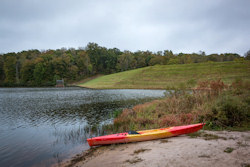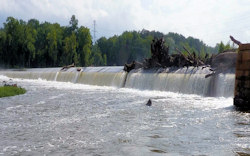Dam Safety Education
Dams provide many valuable functions including support water supplies, irrigation, recreation, hydropower, fish and wildlife habitats, and flood reduction systems. When they fail, however, flooding can be catastrophic.
Recreating in the water? Beware of low-head dams.

Low-head dams, also called “run-of-the-river” dams, are one of the greatest dangers to those who enjoy swimming, boating and floating on waterways. These dams run from bank-to-bank across a river or stream, creating a forceful “spin cycle” under the water’s surface that can trap even the strongest swimmer wearing a flotation device.
Whenever you are on the water, look for the following, which could indicate the presence of a low-head dam:
- A smooth horizon line where the stream meets the sky
- Concrete retaining walls on either side of the water
If you think you spot a low-head dam, it is crucial that you do these 3 things:
- Get out of the water.
- Carry your boat, canoe or kayak around the dam.
- Re-enter the river at a point well downstream.
In cooperation with Virginia Department of Wildlife Resources, we urge everyone to stay safe by avoiding low-head dams while enjoying rivers and streams.
Find more safety tips at https://dwr.virginia.gov/boating/education/lowhead-dams/
Follow these additional tips for general safety around dams while recreating in or near the water:
- Stay off dams not designed specifically for pedestrians as they may have slippery surfaces, grates, indentations and other hazards.
- If swimming or fishing, always remain safely away from all dams to avoid sudden currents.
- If kayaking, canoeing or boating, always carry your boat around the dam, or turn around well before reaching the dam, to avoid being pulled over.
- Obey posted signs and barriers in the area, including flood warnings, restricted-access signs and portage signs.
Dam Safety Awareness Day - Hearthstone Lake
Know Your Risk
- Be aware of smaller agricultural dams in your area that may now considered high hazard dams (a dam whose failure would cause loss of human life). As the number of buildings, businesses and people increases near a dam, so can its classification because it was not built to support current demand.
- There are more than 90,000 dams in the United States according to the 2018 update to the National Inventory of Dams. Approximately a third of these pose a “high” or “significant” hazard to life and property if failure occurs.
- Many dams in the U.S. are nearing their designed lifespan of up to 100 years. Proper maintenance is important to ensure the longest lifespan possible.
To find out if you live in a dam breach inundation zone, contact the local emergency management agency or DCR’s Dam Safety Program staff.
Know Your Role and the Role of Dam Owners
- Know the dams in your areas where you live and work.
- Be aware of potential maintenance issues and report them to owners and authorities immediately.
- Dam owners should work with the federal or state regulator to comply with safety standards.
- Dam owners have the responsibility to maintain their dams and to have an Emergency Action Plan on file with local and state authorities.
Take Action
- Inform friends and neighbors about benefits and risks associated with dams.
- Know your evacuation routes. If you live in coastal Virginia, know your zone.
- Maintain flood insurance if you live near or below a dam.
- Have a plan in place for your family or business should you need to evacuate quickly because of a dam failure upstream.
Dam Owner Academy Videos (Full Playlist):
Resources

 Department of Conservation and Recreation
Department of Conservation and Recreation
 Department of Conservation and Recreation
Department of Conservation and Recreation




